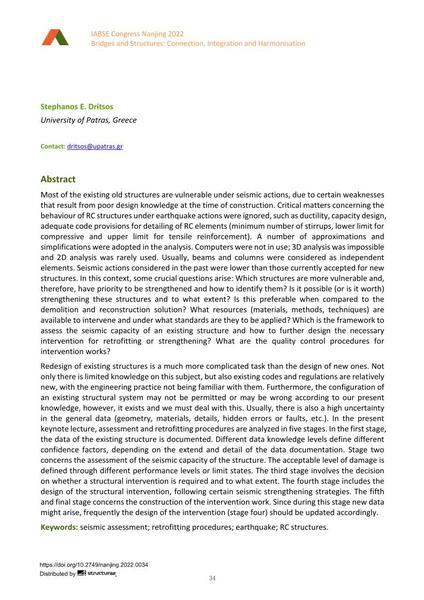|
Abstrait:
|
Most of the existing old structures are vulnerable under seismic actions, due to certain weaknesses that result from poor design knowledge at the time of construction. Critical matters concerning the behaviour of RC structures under earthquake actions were ignored, such as ductility, capacity design, adequate code provisions for detailing of RC elements (minimum number of stirrups, lower limit for compressive and upper limit for tensile reinforcement). A number of approximations and simplifications were adopted in the analysis. Computers were not in use; 3D analysis was impossible and 2D analysis was rarely used. Usually, beams and columns were considered as independent elements. Seismic actions considered in the past were lower than those currently accepted for new structures. In this context, some crucial questions arise: Which structures are more vulnerable and, therefore, have priority to be strengthened and how to identify them? Is it possible (or is it worth) strengthening these structures and to what extent? Is this preferable when compared to the demolition and reconstruction solution? What resources (materials, methods, techniques) are available to intervene and under what standards are they to be applied? Which is the framework to assess the seismic capacity of an existing structure and how to further design the necessary intervention for retrofitting or strengthening? What are the quality control procedures for intervention works? Redesign of existing structures is a much more complicated task than the design of new ones. Not only there is limited knowledge on this subject, but also existing codes and regulations are relatively new, with the engineering practice not being familiar with them. Furthermore, the configuration of an existing structural system may not be permitted or may be wrong according to our present knowledge, however, it exists and we must deal with this. Usually, there is also a high uncertainty in the general data (geometry, materials, details, hidden errors or faults, etc.). In the present keynote lecture, assessment and retrofitting procedures are analyzed in five stages. In the first stage, the data of the existing structure is documented. Different data knowledge levels define different confidence factors, depending on the extend and detail of the data documentation. Stage two concerns the assessment of the seismic capacity of the structure. The acceptable level of damage is defined through different performance levels or limit states. The third stage involves the decision on whether a structural intervention is required and to what extent. The fourth stage includes the design of the structural intervention, following certain seismic strengthening strategies. The fifth and final stage concerns the construction of the intervention work. Since during this stage new data might arise, frequently the design of the intervention (stage four) should be updated accordingly.
|

